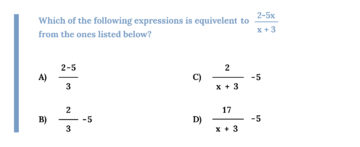The style of questions offered on both the calculator and no calculator sections of the SAT Math are, simply put, unlike most math questions you’ve seen in school. Interestingly, though, most students have actually moved beyond the type of math tested on these sections at least a year prior to taking the test. As such, much of the material tested will seem simultaneously vaguely familiar (in terms of content) and scarily unfamiliar (in terms of question style). Fortunately, like the rest of the SAT, patterns exist and strategies abound. The following strategies in particular are proven to achieve success on this test.
Math – no calculator
1. Linear equations, quadratic equations, systems of equations
The three pillars of SAT math, these three make up the majority of questions on this section. Study them intensely. Wait, did you study them? Study them again, and again.
2. Plug in, creatively
Your math teacher is not grading this test, so who cares about solving with the “correct” methodology? Plugging in is essential. Be creative as you work backwards. For instance, you’ll get many problems that ask you to find “equivalent expressions” of ones given:

This is a difficult problem to solve straightforwardly, and the test makers are aware. That said, if we plug in a value into the top expression — say, x = 1 — we know that whatever value that produces, the correct answer should also produce that answer. When we do, we get -3/4. Going down to the answer choices, the only choice that produces -3/4 when x = 1 is D.
(17/4-5 = 17/4-20/4 = -3/4)
These equivalent expressions problems pop up constantly, so be aware of this shortcut. Note: This is our favorite strategy on the whole math test!
3. Know the key formulas that come up 8 billion times
Slope Intercept, Percent Change, Equation of a Circle, Quadratic Formula, etc. Easy fixes. Additionally, next time you take a practice test, really look at the first page of the Math section. The test maker literally gives you some formulas to work with. Many students are unaware that Area and Circumference of a circle, or that relationship between 30-60-90 triangles, are given to them on the first page. That’s right! They are literally giving you the formulas.
Pro Tip: If you have trouble memorizing other useful formulas, take a moment at the beginning of the section to scribble these down on the top of the first page of the section. Then, move forward. Refer to your little “memory bank” when you need.
4. Factor
This we cannot stress enough. Difference of Squares and Perfect Square Trinomials will appear several times on each test. Your ability to factor will be a huge factor in your success on this section. (We can hear you laughing! SAT jokes are the best jokes.)
5. Long problem? Don’t fall for their trap
This is a tall order for many students, but if the question is a long one, know that the length is likely just there to confuse you. Jump down to the actual question to see if you can answer it without the information. Then scan the answer choices. If you still can’t figure out what the task at hand is, read through the question and underline keywords.
Math – calculator
1. Use your calculator
We know it sounds silly, but don’t forget to use the tool you are given. Understand what algebraic problems mean visually and let your graphing calculator guide you to that answer. For instance, did you know that a solution to a system of equations is just the intersection point between their graphs? Graph and get that solution without even knowing any algebra.
2. Watch out for what they’re asking
Applicable to both Math sections, but often times, an SAT Math question will ask for an expression, rather than just “X” or “Y.” In fact, it’s frequently easier to solve for that specific expression. Ask yourself, why are they having me solve for this specific expression? Let them “meet you halfway.”

This problem would be doable but still relatively cumbersome using our traditional methods of Substitution or Elimination. Instead, notice that just from adding these two equations together initially, we get 5x – 5y = -30. Then, dividing each side by 5, we get x – y = -6 . We’ve solved directly for the expression, both saving time and gaining a sense of victory over the test maker.
3. Standard deviation, line of best fit, two-way tables
Obscure topics, but they come up on just about every test. Learn them, and use them.
4. Use dimensional analysis for conversions
Many students have been introduced to this process in Chemistry. It is extremely applicable and delightfully simple in a process (conversions) that can be very confusing.
5. Write it down, draw it out
You have 55 minutes for 38 questions on this section. In other words, you have time. Don’t feel like you have to do any mental math or geometric picturing. Write down (and number!) those steps. Draw out those coordinate planes. Scribble all over that test booklet. It will ultimately save you time and confusion.


